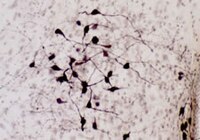PC226L Sigma-AldrichAnti-Oxytocin Rabbit pAb
Recommended Products
Overview
| Replacement Information |
|---|
Key Spec Table
| Host |
|---|
| Rb |
| References | |
|---|---|
| References | Sudhof, T.C. 1995. Nature 375, 645. Hokfelt, T., et al. 1987. Experientia Suppl. 56, 154. |
| Product Information | |
|---|---|
| Form | Lyophilized |
| Formulation | Undiluted serum. |
| Positive control | Rat supraoptic, hypothalamus, or paraventricular |
| Preservative | ≤0.1% sodium azide |
| Biological Information | |
|---|---|
| Immunogen | rat oxytocin |
| Immunogen | Rat |
| Host | Rabbit |
| Isotype | IgG |
| Physicochemical Information |
|---|
| Dimensions |
|---|
| Materials Information |
|---|
| Toxicological Information |
|---|
| Safety Information according to GHS |
|---|
| Safety Information |
|---|
| Product Usage Statements |
|---|
| Packaging Information |
|---|
| Transport Information |
|---|
| Supplemental Information |
|---|
| Specifications |
|---|
| Global Trade Item Number | |
|---|---|
| Catalogue Number | GTIN |
| PC226L | 0 |
Documentation
Anti-Oxytocin Rabbit pAb Certificates of Analysis
| Title | Lot Number |
|---|---|
| PC226L |
References
| Reference overview |
|---|
| Sudhof, T.C. 1995. Nature 375, 645. Hokfelt, T., et al. 1987. Experientia Suppl. 56, 154. |
Citations
| Title | |
|---|---|
|
|








